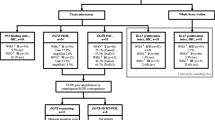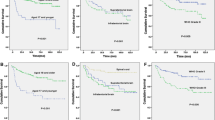Abstract
As the value of grading of ependymomas is currently debated we studied the expression of proliferation- and apoptosis-related proteins in these tumors as these mechanisms both are suggested to be important in tumor growth. We characterized the immunohistochemical expression of p53, Mdm2, Bcl-2, and Bax in 51 intracranial ependymomas. We also assessed the apoptosis- and proliferation-index, measured by MIB-1, PCNA-immunohistochemistry, and analyzed the clinical parameters. Of all used antibodies, the correlation with survival and the correlation among ordered categories was assessed. None of the analyzed immunohistochemical variables were significantly correlated with tumor grade. On the other hand, PCNA, MIB-1, and p53 were significantly related to the survival of the patient. In multivariate analysis, p53 was the only independent predictive variable (p = 0.0132).
Conclusion: The strongest predictors of survival in univariate analysis were the expression of PCNA, MIB-1 and p53. In multivariate analysis a p53 expression >1% showed to be significantly related with a worse survival. The predicting value of p53 expression has to be confirmed by others before solid conclusions can be made. Apoptosis seems not to be an important mechanism in tumor growth in ependymomas. The expression of Mdm2, Bcl-2, and Bax were not related to survival.
Similar content being viewed by others
References
Mork SJ, Loken AC: Ependymoma: a follow-up study of 101 cases. Cancer 40(2): 907-915, 1977
Bijlsma EK, Voesten AM, Bijleveld EH, Troost D, Westerveld A, Merel P, Thomas G, Hulsebos TJ: Molecular analysis of genetic changes in ependymomas. Genes Chromosomes Cancer 13(4): 272-277, 1995
Verstegen MJT, Bosch DA, Troost D: Treatment of ependymomas. Clinical and non-clinical factors influencing prognosis: a review. Br J Neurosurg 11(6): 542-553, 1997
Rogatto SR, Casartelli C, Rainho CA, Barbieri-Neto J: Chromosomes in the genesis and progression of ependymomas. Cancer Genet Cytogenet 69(2): 146-152, 1993
Neumann E, Kalousek DK, Norman MG, Steinbok P, Cochrane DD, Goddard K: Cytogenetic analysis of 109 pediatric central nervous system tumors. Cancer Genet Cytogenet 71(1): 40-49, 1993
Wernicke C, Thiel G, Lozanova T, Vogel S, Kintzel D, Janisch W, Lehmann K, Witkowski R: Involvement of chromosome 22 in ependymomas. Cancer Genet Cytogenet 79(2): 173-176, 1995
von Haken MS, White EC, Daneshvar-Shyesther L, Sih S, Choi E, Kalra R, Cogen PH: Molecular genetic analysis of chromosome arm 17p and chromosome arm 22q DNA sequences in sporadic pediatric ependymomas. Genes Chromosomes Cancer 17(1): 37-44, 1996
Kramer DL, Parmiter AH, Rorke LB, Sutton LN, Biegel JA: Molecular cytogenetic studies of pediatric ependymomas. J Neuro-Oncol 37(1): 25-33, 1998
Reardon DA, Entrekin RE, Sublett J, Ragsdale S, Li H, Boyett J, Kepner JL, Look AT: Chromosome arm 6q loss is the most common recurrent autosomal alteration detected 27 in primary pediatric ependymoma. Genes Chromosomes Cancer 24(3): 230-237, 1999
Levine AJ: The p53 tumor-suppressor gene (editorial; comment). N Engl J Med 326(20): 1350-1352, 1992
Fink KL, Rushing EJ, Schold SC, Jr., Nisen PD: Infrequency of p53 gene mutations in ependymomas. J Neuro-Oncol 27(2): 111-115, 1996
Nozaki M, Tada M, Matsumoto R, Sawamura Y, Abe H, Iggo RD: Rare occurrence of inactivating p53 gene mutations in primary non-astrocytic tumors of the central nervous system: reappraisal by yeast functional assay. Acta Neuropathol (Berlin) 95(3): 291-296, 1998
Haupt Y, Maya R, Kazaz A, Oren M: Mdm2 promotes the rapid degradation of p53. Nature 387(6630): 296-299, 1997
Momand J, Zambetti GP, Olson DC, George D, Levine AJ: The Mdm2 oncogene product forms a complex with the p53 protein and inhibits p53-mediated transactivation. Cell 69(7): 1237-1245, 1992
Landers JE, Haines DS, Strauss JF, III, George DL: Enhanced translation: a novel mechanism of Mdm2 oncogene overexpression identified in human tumor cells. Oncogene 9(9): 2745-2750, 1994
Biernat W, Kleihues P, Yonekawa Y, Ohgaki H: Amplification and overexpression of Mdm2 in primary (de novo) glioblastomas. J Neuropathol Exp Neurol 56(2): 180-185, 1997
Leach FS, Tokino T, Meltzer P, Burrell M, Oliner JD, Smith S, Hill DE, Sidransky D, Kinzler KW, Vogelstein B: p53 Mutation and Mdm2 amplification in human soft tissue sarcomas. Cancer Res 53(suppl 10): 2231-2234, 1993
Reifenberger G, Liu L, Ichimura K, Schmidt EE, Collins VP: Amplification and overexpression of the Mdm2 gene in a subset of human malignant gliomas without p53 mutations. Cancer Res 53(12): 2736-2739, 1993
Capoulade C, Bressac-de Paillerets B, Lefrere I, Ronsin M, Feunteun J, Tursz T, Wiels J: Overexpression of Mdm2, due to enhanced translation, results in inactivation of wildtype p53 in Burkitt's lymphoma cells. Oncogene 16(12): 1603-1610, 1998
Alderson LM, Castleberg RL, Harsh GR, Louis DN, Henson JW: Human gliomas with wild-type p53 express Bcl-2. Cancer Res 55(5): 999-1001, 1995
Miyashita T, Krajewski S, Krajewska M, Wang HG, Lin HK, Liebermann DA, Hoffman B, Reed JC: Tumor suppressor p53 is a regulator of bcl-2 and bax gene expression in vitro and in vivo. Oncogene 9(6): 1799-1805, 1994
Reed JC: Double identity for proteins of the Bcl-2 family. Nature 387(6635): 773-776, 1997
Tsujimoto Y, Gorham J, Cossman J, Jaffe E, Croce CM: The t(14;18) chromosome translocations involved in B-cell neoplasms result from mistakes in VDJ joining. Science 229(4720): 1390-1393, 1985
Cox DR: Regression models and life tables. J R Stat Soc 34B: 187-220, 1972
Kaplan EL, Meier P: Nonparametric estimation from incomplete observations. J Am Stat Assoc 53: 457-481, 1958
Kleihues P, Burger P, Scheithauer B: The new WHO classi-fication of brain tumors. Brain Pathol 3: 255-268, 1993
Hsu SM, Raine L, Fanger H: The use of antiavidin antibody and avidin-biotin-peroxidase complex in immunoperoxidase technics. Am J Clin Pathol 75(6): 816-821, 1981
Figarella-Branger D, Civatte M, Bouvier-Labit C, Gouvernet J, Gambarelli D, Gentet JC, Lena G, Choux M, Pellissier JF: Prognostic factors in intracranial ependymomas in children (see comments). J Neurosurg 93(4): 605-613, 2000
Barone BM, Elvidge AR: Ependymomas. A clinical survey. J Neurosurg 33(4): 428-438, 1970
Dohrmann GJ, Farwell JR: Ependymal neoplasms in children. Trans Am Neurol Assoc 101: 125-129, 1976
Fokes EC, Jr., Earle KM: Ependymomas: clinical and pathological aspects. J Neurosurg 30(5): 585-594, 1969
Hamilton RL, Pollack IF: The molecular biology of ependymomas. Brain Pathol 7(2): 807-822, 1997
Healey EA, Barnes PD, Kupsky WJ, Scott RM, Sallan SE, Black PM, Tarbell NJ: The prognostic significance of postoperative residual tumor in ependymoma. Neurosurgery 28(5): 666-671, 1991
Robertson PL, Zeltzer PM, Boyett JM, Rorke LB, Allen JC, Geyer JR, Stanley P, Li H, Albright AL, McGuire-Cullen P, Finlay JL, Stevens KR, Jr., Milstein JM, Packer RJ, Wisoff J: Survival and prognostic factors following radiation therapy and chemotherapy for ependymomas in children: a report of the Children's Cancer Group (see comments). J Neurosurg 88(4): 695-703, 1998
Ross GW, Rubinstein LJ: Lack of histopathological correlation of malignant ependymomas with postoperative survival. J Neurosurg 70(1): 31-36, 1989
Schiffer D, Chio A, Giordana MT, Migheli A, Palma L, Pollo B, Soffietti R, Tribolo A: Histologic prognostic factors in ependymoma. Childs Nerv Syst 7(4): 177-182, 1991
Schiffer D, Chio A, Cravioto H, Giordana MT, Migheli A, Soffietti R, Vigliani MC: Ependymoma: internal correlations among pathological signs: the anaplastic variant. Neurosurgery 29(2): 206-210, 1991
Schlott T, Reimer S, Jahns A, Ohlenbusch A, Ruschenburg I, Nagel H, Droese M: Point mutations and nucleotide insertions in the Mdm2 zinc finger structure of human tumours. J Pathol 182(1): 54-61, 1997
Fakharzadeh SS, Trusko SP, George DL: Tumorigenic potential associated with enhanced expression of a gene that is amplified in a mouse tumor cell line. EMBO J 10(6): 1565-1569, 1991
Nazar GB, Hoffman HJ, Becker LE, Jenkin D, Humphreys RP, Hendrick EB: Infratentorial ependymomas in childhood; prognostic factors and treatment. J Neurosurg 72: 408-417, 1990
Neumann E, Kalousek DK, Norman MG, Steinbok P, Cochrane DD, Goddard K: Cytogenetic analysis of 109 pedriatric central nervous system tumors. Cancer Genet Cytogenet 71: 40-49, 1993
Salazar OM, Ubin P, Bassano B, Marcial VA: Improved survival of patients with intracranial ependymomas by irradiation: dose selection and field extension. Cancer 35: 1563-1573, 1975
Vanuytsel LJ, Bessell EM, Ashley SE, Bloom HJ, Brada M: Intracranial ependymoma: long-term results of a policy of 28 surgery and radiotherapy. Int J Radiat Oncol Biol Phys 23: 313-319, 1992
Schröder R, Ploner C, Ernestus RI: The growth potential of ependymomas with varying grades of malignancy measured by the Ki-67 labelling index and mitotic index. Neurosurg Rev 16(2): 145-150, 1993
Schiffer D, Chio A, Giordana MT, Pezzulo T, Vigliani MC: Proliferating cell nuclear antigen expression in brain tumors, and its prognostic role in ependymomas: an immunohistochemical study. Acta Neuropathol (Berlin) 85(5): 495-502, 1993
Bennetto L, Foreman N, Harding B, Hayward R, Ironside J, Love S, Ellison D: Ki-67 immunolabelling index is a prognostic indicator in childhood posterior fossa ependymomas. Neuropathol Appl Neurobiol 24(6): 434-440, 1998
Ritter AM, Hess KR, McLendon RE, Langford LA: Ependymomas: MIB-1 proliferation index and survival. J Neuro-Oncol 40(1): 51-57, 1998
Baas IO, Mulder JW, Offerhaus GJ, Vogelstein B, Hamilton SR: An evaluation of six antibodies for immunohistochemistry of mutant p53 gene product in archival colorectal neoplasms. J Pathol 172(1): 5-12, 1994
Korkolopoulou P, Christodoulou P, Kouzelis K, Hadjiyannakis M, Priftis A, Stamoulis G, Seretis A, Thomas-Tsagli E: Mdm2 and p53 expression in gliomas: a multivariate survival analysis including proliferation markers and epidermal growth factor receptor. Br J Cancer 75(9): 1269-1278, 1997
Rushing EJ, Brown DF, Hladik CL, Risser RC, Mickey BE, White CL, III: Correlation of bcl-2, p53, and MIB-1 expression with ependymoma grade and subtype. Mod Pathol 11(5): 464-470, 1998
Schiffer D, Cavalla P, Migheli A, Chio A, Giordana MT, Marino S, Attanasio A: Apoptosis and cell proliferation in human neuroepithelial tumors. Neurosci Lett 195(2): 81-84, 1995
Blok P, Craanen ME, Dekker W, Offerhaus GJ, Tytgat GN: No evidence for functional inactivation of wild-type p53 protein by Mdm2 overexpression in gastric carcinogenesis. J Pathol 186(1): 36-40, 1998
Marchetti A, Buttitta F, Girlando S, Dalla PP, Pellegrini S, Fina P, Doglioni C, Bevilacqua G, Barbareschi M: Mdm2 gene alterations and Mdm2 protein expression in breast carcinomas. J Pathol 175(1): 31-38, 1995
Sigalas I, Calvert AH, Anderson JJ, Neal DE, Lunec J: Alternatively spliced Mdm2 transcripts with loss of p53 binding domain sequences: transforming ability and frequent detection in human cancer. Nat Med 2(8): 912-917, 1996
Matsumoto R, Tada M, Nozaki M, Zhang CL, Sawamura Y, Abe H: Short alternative splice transcripts of the mdm2 oncogene correlate to malignancy in human astrocytic neoplasms. Cancer Res 58(4): 609-613, 1998
Wang Y, Szekely L, Okan I, Klein G, Wiman KG:Wild-type p53-triggered apoptosis is inhibited by bcl-2 in a v-mycinduced T-cell lymphoma line. Oncogene 8(12): 3427-3431, 1993
Schiffer D, Cavalla P, Migheli A, Giordana MT, Chiado-Piat L: Bcl-2 distribution in neuroepithelial tumors: an immunohistochemical study. J Neuro-Oncol 27(2): 101-109, 1996
Rushing EJ, Brown DF, Hladik CL, Risser RC, Mickey BE, White CL, III: Correlation of bcl-2, p53, and MIB-1 expression with ependymoma grade and subtype. Mod Pathol 11(5): 464-470, 1998
Bruggers CS, Fults D, Perkins SL, Coffin CM, Carroll WL: Coexpression of genes involved in apoptosis in central nervous system neoplasms. J Pediatr Hematol Oncol 21(1): 19-25, 1999
Chresta CM, Masters JR, Hickman JA: Hypersensitivity of human testicular tumors to etoposide-induced apoptosis is associated with functional p53 and a high Bax: Bcl-2 ratio. Cancer Res 56(8): 1834-1841, 1996
Karamitopoulou E, Perentes E, Diamantis I, Maraziotis T: Ki-67 immunoreactivity in human central nervous system tumors: a study withMIB1 monoclonal antibody on archival material. Acta Neuropathol (Berlin) 87(1): 47-54, 1994
Rezai AR, Woo HH, Lee M, Cohen H, Zagzag D, Epstein FJ: Disseminated ependymomas of the central nervous system. J Neurosurg 85(4): 618-624, 1996
Prayson RA: Cyclin D1 and MIB-1 immunohistochemistry in ependymomas: a study of 41 cases. Am J Clin Pathol 110(5): 629-634, 1998
Author information
Authors and Affiliations
Rights and permissions
About this article
Cite this article
Verstegen, M., Troost, D., Leenstra, S. et al. Proliferation- and Apoptosis-related Proteins in Intracranial Ependymomas: An Immunohistochemical Analysis. J Neurooncol 56, 21–28 (2002). https://doi.org/10.1023/A:1014471714058
Issue Date:
DOI: https://doi.org/10.1023/A:1014471714058




